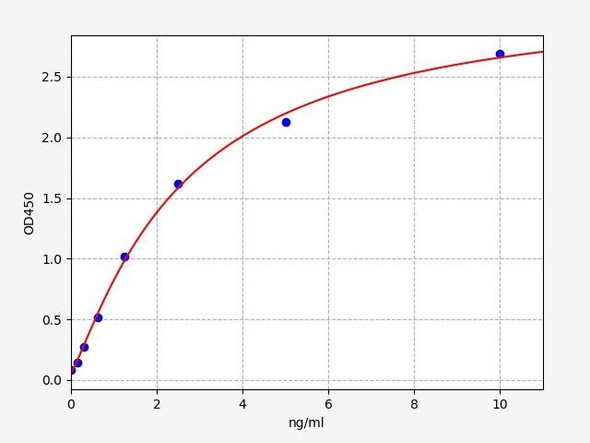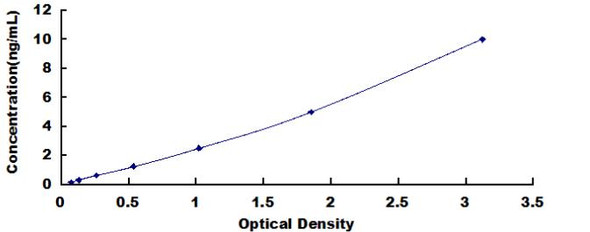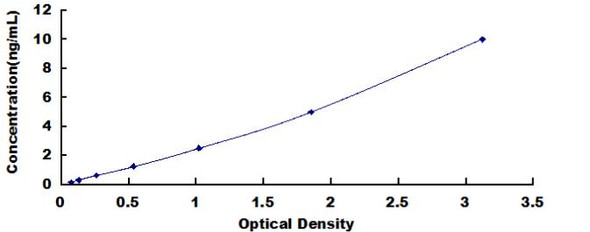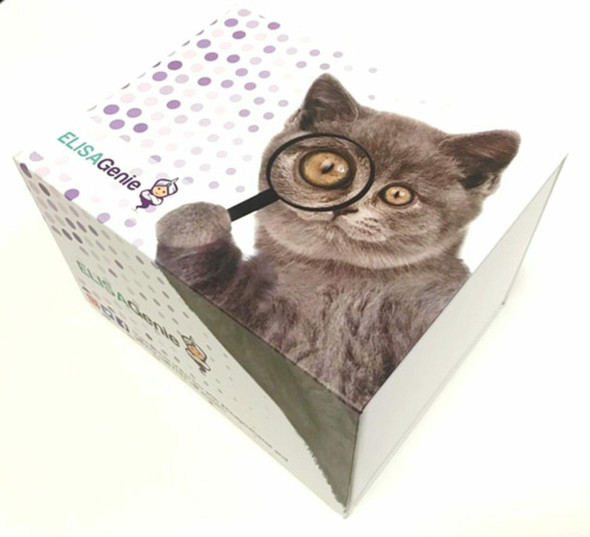Human Tribbles homolog 3 (TRIB3) ELISA Kit (HUEB2711)
- SKU:
- HUEB2711
- Product Type:
- ELISA Kit
- Size:
- 96 Assays
- Uniprot:
- Q96RU7
- Range:
- 0.156-10 ng/mL
- ELISA Type:
- Sandwich
- Synonyms:
- TRIB3, Tribbles homolog 3, TRB-3, p65-interacting inhibitor of NF-kappa-B, Neuronal cell death-inducible putative kinase, SINK
- Reactivity:
- Human
Description
Human Tribbles homolog 3 (TRIB3) ELISA Kit
The Human Tribbles Homolog 3 (TRIB3) ELISA Kit is specifically designed for the precise measurement of TRIB3 levels in human serum, plasma, and cell culture supernatants. This ELISA kit offers exceptional sensitivity and specificity, ensuring accurate and consistent results for various research applications.TRIB3 is a key protein that plays a critical role in regulating diverse cellular processes such as apoptosis, autophagy, and insulin signaling.
Dysregulation of TRIB3 has been implicated in various diseases including cancer, diabetes, and cardiovascular disorders, making it a valuable biomarker for studying disease pathogenesis and potential therapeutic interventions.With its reliable performance and ease of use, the Human TRIB3 ELISA Kit from AssayGenie is an essential tool for researchers looking to investigate the role of TRIB3 in human health and disease.
| Product Name: | Human Tribbles homolog 3 (TRIB3) ELISA Kit |
| SKU: | HUEB2711 |
| Size: | 96T |
| Target: | Human Tribbles homolog 3 (TRIB3) |
| Synonyms: | Neuronal cell death-inducible putative kinase, SINK, p65-interacting inhibitor of NF-kappa-B, TRB-3, C20orf97, NIPK, SKIP3, TRB3 |
| Assay Type: | Sandwich |
| Detection Method: | ELISA |
| Reactivity: | Human |
| Detection Range: | 0.156-10ng/mL |
| Sensitivity: | 0.071ng/mL |
| Intra CV: | 6.3% | ||||||||||||||||||||
| Inter CV: | 10.1% | ||||||||||||||||||||
| Linearity: |
| ||||||||||||||||||||
| Recovery: |
| ||||||||||||||||||||
| Function: | Disrupts insulin signaling by binding directly to Akt kinases and blocking their activation. May bind directly to and mask the 'Thr-308' phosphorylation site in AKT1. Binds to ATF4 and inhibits its transcriptional activation activity. Interacts with the NF-kappa-B transactivator p65 RELA and inhibits its phosphorylation and thus its transcriptional activation activity. Interacts with MAPK kinases and regulates activation of MAP kinases. May play a role in programmed neuronal cell death but does not appear to affect non-neuronal cells. Does not display kinase activity. Inhibits the transcriptional activity of DDIT3/CHOP and is involved in DDIT3/CHOP-dependent cell death during ER stress. Can inhibit APOBEC3A editing of nuclear DNA. |
| Uniprot: | Q96RU7 |
| Sample Type: | Serum, plasma, tissue homogenates, cell culture supernates and other biological fluids |
| Specificity: | Natural and recombinant human Tribbles homolog 3 |
| Sub Unit: | Interacts with AKT1, AKT2, ATF4, MAP2K1 and MAP2K7. Interacts with DDIT3/CHOP and inhibits its interaction with EP300/P300. Interacts (via N-terminus) with APOBEC3A. Interacts with APOBEC3C. |
| Research Area: | Cancer |
| Subcellular Location: | Nucleus |
| Storage: | Please see kit components below for exact storage details |
| Note: | For research use only |
| UniProt Protein Function: | TRB3: a Ca(2)/calmodulin-dependent protein kinase of the Trbl family. Induced by the transcription factor NF-kappaB. The encoded protein is a negative regulator of NF-kappaB and can also sensitize cells to TNF- and TRAIL-induced apoptosis. May negatively regulate the cell survival kinase AKT1. |
| UniProt Protein Details: | Protein type:Protein kinase, Ser/Thr (non-receptor); Kinase, protein; Protein kinase, CAMK; CAMK group; Trbl family Chromosomal Location of Human Ortholog: 20p13-p12.2 Cellular Component: nucleoplasm; plasma membrane; cytosol; nucleus Molecular Function:protein binding; protein kinase inhibitor activity; ubiquitin protein ligase binding; ubiquitin-protein ligase regulator activity; kinase activity; transcription corepressor activity; protein kinase binding; ATP binding Biological Process: epidermal growth factor receptor signaling pathway; fibroblast growth factor receptor signaling pathway; phosphoinositide-mediated signaling; transcription, DNA-dependent; nerve growth factor receptor signaling pathway; positive regulation of protein binding; cellular lipid metabolic process; negative regulation of transcription from RNA polymerase II promoter; negative regulation of fat cell differentiation; protein amino acid phosphorylation; cellular response to insulin stimulus; regulation of MAP kinase activity; positive regulation of ubiquitin-protein ligase activity; insulin receptor signaling pathway; negative regulation of protein kinase activity; innate immune response; negative regulation of transcription, DNA-dependent; negative regulation of fatty acid biosynthetic process |
| NCBI Summary: | The protein encoded by this gene is a putative protein kinase that is induced by the transcription factor NF-kappaB. The encoded protein is a negative regulator of NF-kappaB and can also sensitize cells to TNF- and TRAIL-induced apoptosis. In addition, this protein can negatively regulate the cell survival serine-threonine kinase AKT1. Differential promoter usage and alternate splicing result in multiple transcript variants. [provided by RefSeq, Jul 2014] |
| UniProt Code: | Q96RU7 |
| NCBI GenInfo Identifier: | 28201830 |
| NCBI Gene ID: | 57761 |
| NCBI Accession: | Q96RU7.2 |
| UniProt Related Accession: | Q96RU7 |
| Molecular Weight: | 35kDa |
| NCBI Full Name: | Tribbles homolog 3 |
| NCBI Synonym Full Names: | tribbles pseudokinase 3 |
| NCBI Official Symbol: | TRIB3 |
| NCBI Official Synonym Symbols: | NIPK; SINK; TRB3; SKIP3; C20orf97 |
| NCBI Protein Information: | tribbles homolog 3 |
| UniProt Protein Name: | Tribbles homolog 3 |
| UniProt Synonym Protein Names: | Neuronal cell death-inducible putative kinase; SINK; p65-interacting inhibitor of NF-kappa-B |
| Protein Family: | Tribbles |
| UniProt Gene Name: | TRIB3 |
| UniProt Entry Name: | TRIB3_HUMAN |
| Component | Quantity (96 Assays) | Storage |
| ELISA Microplate (Dismountable) | 8×12 strips | -20°C |
| Lyophilized Standard | 2 | -20°C |
| Sample Diluent | 20ml | -20°C |
| Assay Diluent A | 10mL | -20°C |
| Assay Diluent B | 10mL | -20°C |
| Detection Reagent A | 120µL | -20°C |
| Detection Reagent B | 120µL | -20°C |
| Wash Buffer | 30mL | 4°C |
| Substrate | 10mL | 4°C |
| Stop Solution | 10mL | 4°C |
| Plate Sealer | 5 | - |
Other materials and equipment required:
- Microplate reader with 450 nm wavelength filter
- Multichannel Pipette, Pipette, microcentrifuge tubes and disposable pipette tips
- Incubator
- Deionized or distilled water
- Absorbent paper
- Buffer resevoir
*Note: The below protocol is a sample protocol. Protocols are specific to each batch/lot. For the correct instructions please follow the protocol included in your kit.
Allow all reagents to reach room temperature (Please do not dissolve the reagents at 37°C directly). All the reagents should be mixed thoroughly by gently swirling before pipetting. Avoid foaming. Keep appropriate numbers of strips for 1 experiment and remove extra strips from microtiter plate. Removed strips should be resealed and stored at -20°C until the kits expiry date. Prepare all reagents, working standards and samples as directed in the previous sections. Please predict the concentration before assaying. If values for these are not within the range of the standard curve, users must determine the optimal sample dilutions for their experiments. We recommend running all samples in duplicate.
| Step | |
| 1. | Add Sample: Add 100µL of Standard, Blank, or Sample per well. The blank well is added with Sample diluent. Solutions are added to the bottom of micro ELISA plate well, avoid inside wall touching and foaming as possible. Mix it gently. Cover the plate with sealer we provided. Incubate for 120 minutes at 37°C. |
| 2. | Remove the liquid from each well, don't wash. Add 100µL of Detection Reagent A working solution to each well. Cover with the Plate sealer. Gently tap the plate to ensure thorough mixing. Incubate for 1 hour at 37°C. Note: if Detection Reagent A appears cloudy warm to room temperature until solution is uniform. |
| 3. | Aspirate each well and wash, repeating the process three times. Wash by filling each well with Wash Buffer (approximately 400µL) (a squirt bottle, multi-channel pipette,manifold dispenser or automated washer are needed). Complete removal of liquid at each step is essential. After the last wash, completely remove remaining Wash Buffer by aspirating or decanting. Invert the plate and pat it against thick clean absorbent paper. |
| 4. | Add 100µL of Detection Reagent B working solution to each well. Cover with the Plate sealer. Incubate for 60 minutes at 37°C. |
| 5. | Repeat the wash process for five times as conducted in step 3. |
| 6. | Add 90µL of Substrate Solution to each well. Cover with a new Plate sealer and incubate for 10-20 minutes at 37°C. Protect the plate from light. The reaction time can be shortened or extended according to the actual color change, but this should not exceed more than 30 minutes. When apparent gradient appears in standard wells, user should terminatethe reaction. |
| 7. | Add 50µL of Stop Solution to each well. If color change does not appear uniform, gently tap the plate to ensure thorough mixing. |
| 8. | Determine the optical density (OD value) of each well at once, using a micro-plate reader set to 450 nm. User should open the micro-plate reader in advance, preheat the instrument, and set the testing parameters. |
| 9. | After experiment, store all reagents according to the specified storage temperature respectively until their expiry. |
When carrying out an ELISA assay it is important to prepare your samples in order to achieve the best possible results. Below we have a list of procedures for the preparation of samples for different sample types.
| Sample Type | Protocol |
| Serum | If using serum separator tubes, allow samples to clot for 30 minutes at room temperature. Centrifuge for 10 minutes at 1,000x g. Collect the serum fraction and assay promptly or aliquot and store the samples at -80°C. Avoid multiple freeze-thaw cycles. If serum separator tubes are not being used, allow samples to clot overnight at 2-8°C. Centrifuge for 10 minutes at 1,000x g. Remove serum and assay promptly or aliquot and store the samples at -80°C. Avoid multiple freeze-thaw cycles. |
| Plasma | Collect plasma using EDTA or heparin as an anticoagulant. Centrifuge samples at 4°C for 15 mins at 1000 × g within 30 mins of collection. Collect the plasma fraction and assay promptly or aliquot and store the samples at -80°C. Avoid multiple freeze-thaw cycles. Note: Over haemolysed samples are not suitable for use with this kit. |
| Urine & Cerebrospinal Fluid | Collect the urine (mid-stream) in a sterile container, centrifuge for 20 mins at 2000-3000 rpm. Remove supernatant and assay immediately. If any precipitation is detected, repeat the centrifugation step. A similar protocol can be used for cerebrospinal fluid. |
| Cell culture supernatant | Collect the cell culture media by pipette, followed by centrifugation at 4°C for 20 mins at 1500 rpm. Collect the clear supernatant and assay immediately. |
| Cell lysates | Solubilize cells in lysis buffer and allow to sit on ice for 30 minutes. Centrifuge tubes at 14,000 x g for 5 minutes to remove insoluble material. Aliquot the supernatant into a new tube and discard the remaining whole cell extract. Quantify total protein concentration using a total protein assay. Assay immediately or aliquot and store at ≤ -20 °C. |
| Tissue homogenates | The preparation of tissue homogenates will vary depending upon tissue type. Rinse tissue with 1X PBS to remove excess blood & homogenize in 20ml of 1X PBS (including protease inhibitors) and store overnight at ≤ -20°C. Two freeze-thaw cycles are required to break the cell membranes. To further disrupt the cell membranes you can sonicate the samples. Centrifuge homogenates for 5 mins at 5000xg. Remove the supernatant and assay immediately or aliquot and store at -20°C or -80°C. |
| Tissue lysates | Rinse tissue with PBS, cut into 1-2 mm pieces, and homogenize with a tissue homogenizer in PBS. Add an equal volume of RIPA buffer containing protease inhibitors and lyse tissues at room temperature for 30 minutes with gentle agitation. Centrifuge to remove debris. Quantify total protein concentration using a total protein assay. Assay immediately or aliquot and store at ≤ -20 °C. |
| Breast Milk | Collect milk samples and centrifuge at 10,000 x g for 60 min at 4°C. Aliquot the supernatant and assay. For long term use, store samples at -80°C. Minimize freeze/thaw cycles. |








